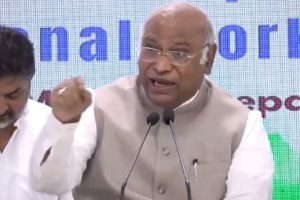Old habits die hard, and so does the deeply ingrained feudal mindset of our rulers who feel that they are and shall always remain more equal than all others, no matter if the country they live in happens to be a democracy that promises equal rights and liberties to every citizen. So they are not likely to easily give up one of their numerous privileges ~ the use of a symbol of power to flaunt. It was first the ubiquitous red beacon, which then mutated into the blue beacon and now it has metamorphosed into a flag, of different sizes and shapes. A mere tokenism like the Central Government’s order prohibiting use of all kinds of beacons by ministers and bureaucrats; it was not expected to make any serious dent into the entrenched feudal mindset of our rulers. However, one was sadly mistaken in believing that the rulers and rule-makers will at least show the courteousness to follow rules. One forgot that they are known more for bending the rules to suit their needs ~ in this case, their lust for clinging to the vestiges of some imagined power whose charm and relevance are fast disappearing in a modernising India that is gradually shedding its medieval appendages.
The beacons, in red, yellow, blue, amber and white, signified the various shades of our VIP culture and our sacred feudal inheritance. At the sight of these propitious lights, traffic gets cleared instantly while all others are made to wait, toll plaza barriers are lifted automatically with no fees charged and duty officers smartly stand up and salute the cars carrying the holy agents of our Mai Baap Sarkar. But then a thoughtless Central order has spelled the ultimate doom for these fabulous privileges enjoyed by the mighty and powerful in this land of the ordinary and the untouchables.
Advertisement
From May 1, the Centre has banned the use of beacons on cars used by VIPs ~ ministers, politicians, bureaucrats and all other dignitaries. The ban doesn’t exempt even the country’s highest dignitaries ~ President, Prime Minister and Chief Justice. Only ambulances and vehicles of emergency and security services ~ fire brigade, police and army ~ are allowed to use beacons, for reasons no one will question. But the lal-batti culture, equated with the status symbol ever since the colonial rulers had introduced the embroidery, was sought to be ended once and for all, even though no one expected the colonial mind that has nurtured and flaunted it to be reformed overnight. Rule 108 the Central Motor Vehicles Rules, 1989, that gave the states the power to decide who should be allowed to display red and blue beacons has been amended, removing Clauses 1(iii), 2, 3, 5 and 6 vide Gazette Notification dated 1 May 2017 and the states now have no power to amend these rules to reintroduce the omnipresent beacons widely despised by everyone other than their users (beneficiaries?).
West Bengal has now found a unique and ingenuous way to beat the Centre’s beacon ban for government vehicles. The state seems yet to retain some residue of its once-famed brainpower, even though it is now counted among the laggard states in India in terms of educational standards, economic prosperity and political violence, indeed factors that are driving its remaining talent fast towards the greener southern pastures of the country. The West Bengal government has just notified a scheme under which senior officials of the Indian Administrative Service, who represent the government at various levels, can use different types of flags on their official vehicles.
As per the “flag scheme”, three types of flags ~ rectangular, swallow-tailed and triangular ~ have been notified depending on the rank of the official for use on the bonnet of their designated vehicles. While the rectangular, 10”X6”, navy blue colour flags will be used by the Chief Secretary, Additional Chief Secretaries and Principal Secretaries, the Secretaries will be allowed to use swallow-tailed flags. The Divisional Commissioners can use only a rectangular flag, while Commissioners can use only a triangular flags. Not to leave out the districts, the District Magistrates have been allowed to use triangular flags. The Personnel and Administrative Department’s notification justifies the scheme using a queer logic, “In view of the significant rise in the level of interaction with various international and national level authorities, it is felt that a flag for use on vehicles being used by senior officials of the state government shall convey a greater sense of government’s intent and enable smoother interactions without compromising protocol.”
Even before the ban came into effect, the West Bengal Chief Minister was not known to use any beacon or even a pilot vehicle, like many Union and State Ministers, among them the CMs of Delhi, Uttar Pradesh and Punjab, Arvind Kejriwal, Yogi Adityanath and Captain Amarinder Singh, and Union Ministers Venkaiah Naidu and Kiren Rijiju. While most ministers and officials in the Union and the states have gracefully abided by the decision, some have stubbornly refused. There are many instances of vehicles of VIPs, officials and unauthorised persons defying the ban in West Bengal, Bihar, Karnataka, and other places, including even lower-level politicians and officials, on the pretext that such a ban could pose challenges in case of law and order problems and for enforcement (which in any case has not been affected by the ban).
Kolkata’s Shahi Imam Maulana Barkati had earlier defied the orders, saying the beacon has been there for “hundreds of years” and accused the RSS of trying to convert India into a Hindu Rashtra, which was apparently being facilitated by removal of the beacon. He was, however, persuaded to remove it. In Karnataka, the Minister for Food and Civil Supplies refused to remove the red beacon, questioning how such a move would help poor people and remove their hunger, implying that by flaunting the beacon he was actually helping their cause. West Bengal’s PWD Minister, Arup Biswas, and the Chairman of Siliguri Jalpaiguri Development Authority were seen using the beacon long after the ban had come into effect, while the Bihar Transport Commissioner RK Mishra had said that the ban on beacon lights would not be enforced in Bihar till the central government had ‘resolved’ objections raised by the state against the already amended Rule 108. Clearly, the Transport Commissioner did not care for the transport laws of the country. But VIPs in our country are always a law unto themselves, as demonstrated clearly by the recent unruly behaviour of Shiv Sena MP Ravindra Gaikwad and TDP MP Diwakar Reddy.
Let alone removing a powerful symbol of power, the ban is unlikely to be followed in a country where concepts of public service, civic sense, decency, civilised behaviour and democracy have all acquired perverted meanings. All attempts to do away with such symbols of depravity had failed earlier. The ban has come three years after the Supreme Court had called the widespread use of red lights “reflective of the Raj mentality and the antithesis of the concept of a Republic.” On 10 December 2013, the Court had ruled (in Abhay Singh Vs. State of Uttar Pradesh and Others) that vehicles fitted with red beacons will be allowed only for dignitaries and directed all authorities to enforce these orders within a month. Nothing really happened. The initial list of five dignitaries was expanded to 12 and then to 27 while state officials and politicians merrily continued to flout all rules. An American academic on his first visit to India a few years ago, with whom I was travelling in Kolkata during the peak morning office hours, was watching with keen interest the passing ambassador cars flashing red beacons, their windows screened, and white lace curtains. I was amused by his remark that he had heard of the famed Indian Jugaad, but never known that ambulances could be innovated and recreated in such an exciting manner. I had to explain it to him that these were not ambulances run by hospitals for ordinary patients, but ambulances run by the state machinery for people sick with a sense of power they did not possess. While actual power continued to drift away from their inept hands, they had been clinging to the symbols ever harder. They shall never let these go.











